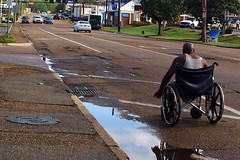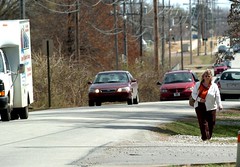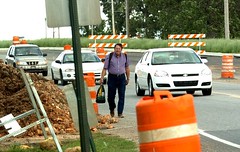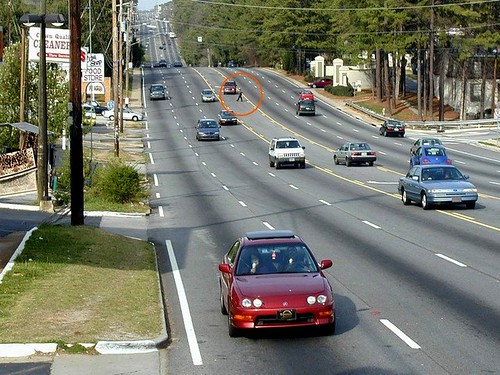‘Dangerous by Design’ report faults systematic inattention to pedestrian safety

Posted November 12, 2009 at 1:38PM
Transportation for America's website introduces its important new report, Dangerous by Design, with an attention-grabbing statistic:
"In the last 15 years, more than 76,000 Americans have been killed while crossing or walking along a street in their community. More than 43,000 Americans - including 3,906 children under 16 - have been killed this decade alone. This is the equivalent of a jumbo jet going down roughly every month, yet it receives nothing like the kind of attention that would surely follow such a disaster."
The report's central point, a critical one, is that this tragedy is not recurring merely because of accident: many of these deaths are preventable. A huge portion occurs along streets and roads that have been engineered exclusively or primarily for fast, efficient car travel, with little or no provision for people on foot, in wheelchairs or on a bicycle. The roads frequently do a poor job of accommodating public transit as well; many pedestrian injuries and deaths occur near bus stops.
Transportation for America (T4America) stresses that these facts are occurring with little attention other than hand-wringing in many jurisdictions precisely at a moment in our history when walking, bicycling, and taking transit are becoming more important.  The public health community now recognizes that "active transportation" helps promote fitness and reduce obesity and related disease; environmental professionals know that we must reduce automobile dependence in order to reduce global warming emissions; and economic analysts advise that we can no longer afford the infrastructure necessary to underwrite continuing automobile supremacy in the context of a growing population.
The public health community now recognizes that "active transportation" helps promote fitness and reduce obesity and related disease; environmental professionals know that we must reduce automobile dependence in order to reduce global warming emissions; and economic analysts advise that we can no longer afford the infrastructure necessary to underwrite continuing automobile supremacy in the context of a growing population.
Over the last several decades, according to Dangerous by Design (co-written with the Surface Transportation Policy Partnership), ever-widening arterial highways have drawn increasing numbers of shopping centers, drive-through services, apartment complexes and office parks. But the pressure to move as many cars through these areas as quickly as possible has led transportation departments to squeeze in as many lanes as they can, often designing out sidewalks, crosswalks and crossing signals, on-street parking, and even street trees in order to remove impediments to motorized traffic:
"As a result, more than half of fatal vehicle crashes occurred on these wide, high capacity and high-speed thoroughfares. Though dangerous, these arterials are all but unavoidable because they are the trunk lines carrying most local traffic and supporting nearly all the commercial activity essential to daily life. These roads have an enormous impact on residential neighborhoods, as well: For example, a recent AARP poll of adults 50 years and older found that 40% reported inadequate sidewalks in their neighborhoods and nearly half of respondents reported that they could not safely cross the main roads close to their home."
This report, which ranks metro areas on the degree of risk presented to pedestrians, also analyzes state and regional spending of federal transportation dollars on pedestrian safety.  It finds that many of the regions in greatest need of improvement are, unfortunately, spending the least amount on pedestrian safety projects. Nationwide, less than 1.5 percent of funds authorized under current federal transportation law have been allocated for projects to improve the safety of walking and bicycling, even though pedestrians comprise 11.8 percent of all traffic deaths and trips made on foot account for almost 9 percent of total trips.
It finds that many of the regions in greatest need of improvement are, unfortunately, spending the least amount on pedestrian safety projects. Nationwide, less than 1.5 percent of funds authorized under current federal transportation law have been allocated for projects to improve the safety of walking and bicycling, even though pedestrians comprise 11.8 percent of all traffic deaths and trips made on foot account for almost 9 percent of total trips.
To be honest, I'm not a huge fan of ranking cities or states on their performance, because one can always quibble with methodology. But they are immensely popular with the media and thus have become a tried-and-true staple of our business. And they do provide a rough indication of where the greatest problems (or successes) lie. Here are the report's top ten most dangerous metro areas for walking:
- Orlando-Kissimmee, FL
- Tampa-St. Petersburg-Clearwater, FL
- Miami-Fort Lauderdale-Pompano Beach, FL
- Jacksonville, FL
- Memphis, TN-MS-AR
- Raleigh-Cary, NC
- Louisville/Jefferson County, KY-IN
- Houston-Sugar Land-Baytown, TX
- Birmingham-Hoover, AL
- Atlanta-Sandy Springs-Marietta, GA
All but one or two (depending on how you count Louisville and Memphis) are sprawling Sun Belt locations. That's pretty much true for numbers eleven through twenty as well.  The five safest, relatively speaking? Minneapolis, Boston, New York, Pittsburgh, and Seattle.
The five safest, relatively speaking? Minneapolis, Boston, New York, Pittsburgh, and Seattle.
The researchers based the rankings on an index that corrects for the fact that cities where more people walk on a daily basis are also likely to have a greater number of pedestrian fatalities, by computing the rate of pedestrian deaths relative to the amount of walking residents do on average.
The report also highlights community actions that can work to lower the risk to pedestrians and cyclists, including street design, "complete streets," safe routes to school programs, and walkable neighborhoods. All of these should be promoted in the upcoming federal transportation reauthorization, say the authors, and I agree. Go here for the introduction and here to download the full report.
